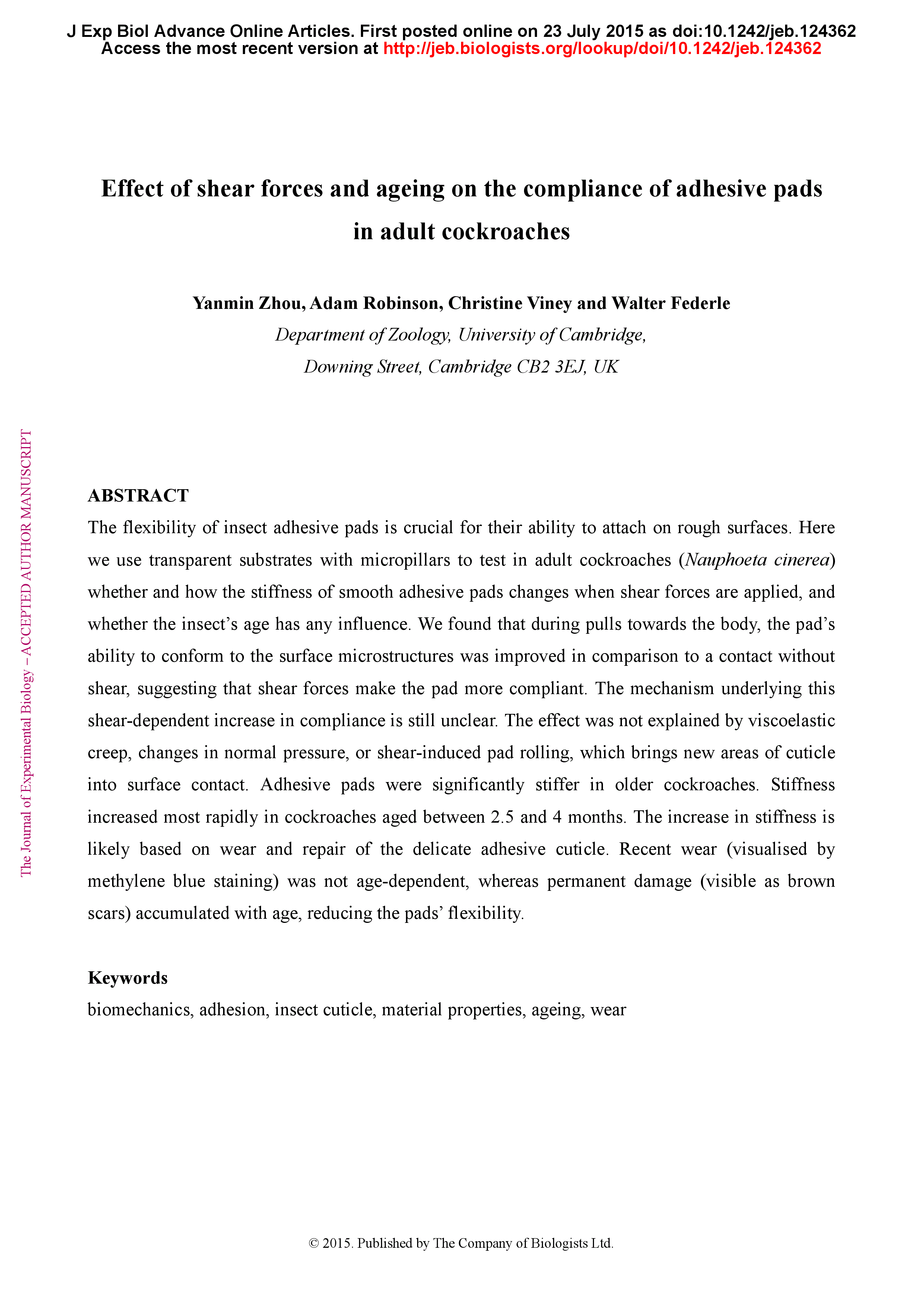The flexibility of insect adhesive pads is crucial for their ability to attach on rough surfaces. Here we use transparent substrates with micropillars to test in adult cockroaches (Nauphoeta cinerea) whether and how the stiffness of smooth adhesive pads changes when shear forces are applied, and whether the insect's age has any influence. We found that during pulls towards the body, the pad's ability to conform to the surface microstructures was improved in comparison to a contact without shear, suggesting that shear forces make the pad more compliant. The mechanism underlying this shear-dependent increase in compliance is still unclear. The effect was not explained by viscoelastic creep, changes in normal pressure, or shear-induced pad rolling, which brings new areas of cuticle into surface contact. Adhesive pads were significantly stiffer in older cockroaches. Stiffness increased most rapidly in cockroaches aged between 2.5 and 4 months. The increase in stiffness is likely based on wear and repair of the delicate adhesive cuticle. Recent wear (visualised by methylene blue staining) was not age-dependent, whereas permanent damage (visible as brown scars) accumulated with age, reducing the pads' flexibility.
Effect of shear forces and ageing on the compliance of adhesive pads in adult cockroaches
Currently Viewing Accepted Manuscript - Newer Version Available
Yanmin Zhou, Adam Robinson, Christine Viney, Walter Federle; Effect of shear forces and ageing on the compliance of adhesive pads in adult cockroaches. J Exp Biol 2015; jeb.124362. doi: https://doi.org/10.1242/jeb.124362
Download citation file:
Advertisement
2023 JEB Outstanding Paper Prize shortlist and winner

The JEB Editors are delighted to announce the shortlisted authors for the 2023 JEB Outstanding Paper Prize. Read the winning paper - Tiny spies: mosquito antennae are sensitive sensors for eavesdropping on frog calls - by Hoover Pantoja-Sanchez and Brian Leavell from Ximena Bernal's lab at Purdue University, USA.
JEB Science Communication Workshop for ECRs

If you’re an early-career researcher interested in science communication and are attending the SEB Annual Conference in Prague this summer, come a day early and join the JEB Editors at a sci comm workshop to learn the key writing skills needed to promote your research to a broad audience beyond your peers (1 July at 14.30-17.30). Places are limited to 24 attendees, and applicants should apply through the SEB registration page by 30 April 2024.
Bridging the gap between controlled conditions and natural habitats in understanding behaviour

Novel technologies enable behavioural experiments with non-model species, in naturalistic habitats and with underexplored behaviours. In their Commentary, Scholz and colleagues discuss how to obtain a deeper understanding of the natural ecology and lifestyle of study animals.
Beluga metabolic measures could help save species

To help save animals from extinction, it’s important to understand what each species needs to survive. This led Jason John et al. to measure the metabolic rates of captive belugas to develop a ‘fish calculator’ showing that the whales need to eat ~23 salmon per day.
ECR Workshop on Positive Peer Review

Are you an ECR looking for tips on how to write concise, astute and useful manuscript reviews? If so, join the JEB Editors at a 2-hour JEB-sponsored Workshop on Positive Peer Review at the Canadian Society of Zoologists annual meeting in Moncton on 9 May 2024 at 13.00-15.00. There are 25 spaces for ECRs and selection is first come, first serve. To sign up, check the ECR Workshop box when you register for the CSZ meeting.



